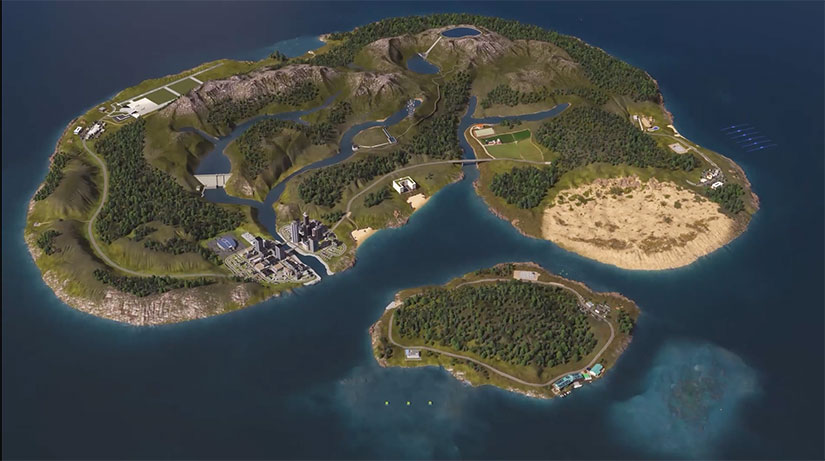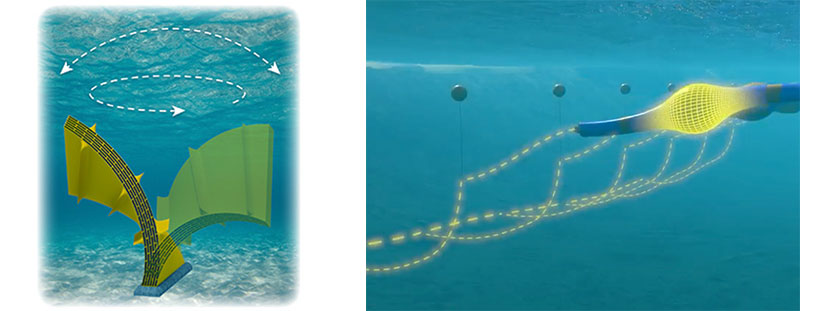A (Virtual) Deep Dive Into Marine Energy's Capabilities
Renewable Energy Discovery Island Offers Closer Look at Power Beneath the Waves

REDi Island will ultimately house 15 different waystations that demonstrate how all types of water power can be used to power our clean energy future. Illustration by IKM 3D
There is big energy lying under the waves that crash on our shores and in the tides that come in and out each day like clockwork: so much power that, if we tapped all the marine energy we have access to, it would be equivalent to nearly 60% of the United States' power generation in 2019. Even if we capture only a portion of this potential, marine energy could make significant contributions to our electricity needs.
How researchers at the National Renewable Energy Laboratory (NREL) are working to tap that potential is where it gets really interesting. And now, teachers, students—and anyone else with a passion for renewables—can visit Renewable Energy Discovery (REDi) Island to virtually see cutting-edge marine energy technologies in action.
REDi Island is a new educational resource developed by the water power team at NREL and IKM 3D with funding from the U.S. Department of Energy’s Water Power Technologies Office. Dive in to explore all that water power has to offer.
Toughening Up the Turbines in Tidal Town

NREL researchers are working to develop resilient, sustainable materials for tidal turbines that could spend up to 20 years underwater. Illustration by IKM 3D; Photo by Dennis Schroeder, NREL
Tidal turbines, like those found in Tidal Town, are a promising technology that could provide power to many coastal communities by capturing the inherent energy in the ebb and flow of tides. But because they are subjected to saltwater day in and day out, the devices must be made from durable materials.
“For marine renewable energy to be successful, it has to be cost-effective, so it's really important to find ways that we can make turbine components—such as the blades—out of materials that are going to last in the harsh environments,” said Robynne Murray, a research engineer at NREL. Murray and her colleagues are continually developing new iterations of tidal turbine blade designs and materials that can withstand 20 years underwater—and that have the potential to be recyclable at the end of their lives.
“I'm really excited about one of the new materials we’re researching: a recyclable epoxy material invented here at NREL that we can make from sugar stock or other biological materials,” Murray said. “It’s recyclable, like thermoplastics, can be made from nonpetroleum products, which helps to decarbonize the energy sector, and can withstand the loads of operating tidal turbines as well as traditional composite materials.”
The tidal energy research team next hopes to deploy a set of composite tidal turbine blades—designed and made at NREL—on the University of New Hampshire’s Living Bridge test site, with the goal of collecting real-world data about the performance of their blades.
Capturing Energy on Bulge Wave Boulevard

NREL’s patented distributed embedded energy converter technologies (left) could be used for a variety of marine energy applications, such as the one demonstrated in REDi Island’s Bulge Wave Boulevard (right).
In 2022, an NREL team received a patent for a novel form of marine energy technology: distributed embedded energy converter technologies (or DEEC-Tec, for short). In this technology domain, small, individual energy converters (DEECs) can be fused or stitched together in larger configurations to capture energy. Their size and flexibility means they can be assembled into a variety of shapes and structures, such as the bulge wave energy converters on REDi Island, which are long, narrow tubes lined with DEECs that are activated by the pressure of oncoming waves.
“DEEC-Tec gives researchers and developers an entirely new way of thinking about how to convert marine energy from ocean waves, tides, and currents into more usable forms of energy,” said Blake Boren, a senior engineer at NREL and the lead inventor on the patent.
DEEC-Tec devices have the potential to be more resilient, cost-effective, and flexible in where they can be installed, which could have a major positive impact on the capacity of the marine energy industry. Boren and his team will continue to explore the potential of this still relatively new domain in hopes of creating the next generation of marine energy devices.
Addressing Water Scarcity at Desalination Station

NREL researchers are developing methods to use wave energy to power reverse osmosis desalination systems in areas where clean drinking water is scarce. Illustration by IKM 3D; Photo courtesy Coastal Studies Institute
Growing water scarcity around the world has inspired innovations focused on wave-powered desalination as a way to get clean drinking water to people in remote or coastal communities—which is especially helpful in disaster-relief scenarios and other places where water infrastructure is not as robust as in the continental United States.
In 2020, NREL set out to create its own compact wave-powered desalination device: the hydraulic and electric reverse osmosis (HERO) wave energy converter (WEC). The HERO WEC can desalinate seawater using a hydraulic or electric power conversion system that is powered by the up-and-down motion of waves. The generated electricity is transmitted to shore via cables to a pump that draws water from the ocean and pushes it through a reverse osmosis desalination system—much like the process demonstrated in Desalination Station.
“At the end of the day, access to drinkable water is something that people from all walks of life understand and care about,” said Scott Jenne, NREL's marine energy systems engineering and techno-economic lead. “Wave energy could make a real impact on the lives of people in coastal communities and maritime industries around the globe."
The HERO WEC has now undergone two open-water deployments—with a third planned later in 2023—and each one has provided more information about the device’s electrical and desalination capabilities. The data gathered will be made publicly available to assist other WEC developers, who rely on validated designs and proven solutions in their development process.
Visit the other marine energy-focused waystations on REDi Island:
- Aquaculture Arena
- Cooling Concourse
- Hydrokinetic Haven
- Navigation Network
- Research Reef
- Surge Flap Sands
Expanding the Reach of REDi Island
REDi Island is a virtual, renewable-energy-powered world that demonstrates all the ways marine energy and hydropower can be used as we transition to clean energy. The tool is part of NREL's water power outreach and education efforts designed to encourage future generations to explore a career in renewable energy and to help ensure that the future of hydropower and marine energy remains robust and sustainable.
The NREL team will next launch an interactive app that allows users to virtually hop from one waystation on the island to another to quickly learn more about each technology. In the coming years, the team hopes to ultimately integrate a video-game-type function into the island for engagement with younger children.
Learn more about science, technology, engineering, and mathematics (STEM) careers and workforce development opportunities in marine energy. And stay up to date on other exciting research by subscribing to NREL's water power newsletter, The Current.
Last Updated May 28, 2025
